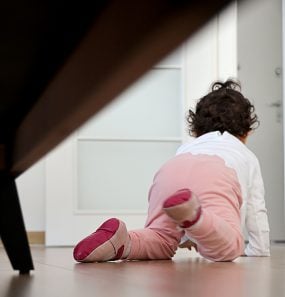At a glance
No safe level of lead in children has been identified. Even low levels of lead in blood can hurt a child's ability to learn, pay attention, and do well in school. The good news is that childhood lead poisoning is preventable. Learn about common sources of lead and steps to reduce your child's risk of lead exposure.

Know the common sources of lead
Lead can be found where children live, play, and learn.
- Paint. In homes or buildings built before 1978, assume that the paint contains lead unless tests show otherwise. When the paint peels and cracks, it makes lead paint chips and dust. Children can be exposed to lead if they eat flaking paint chips or breathe in lead dust.
- Soil. Lead particles from exterior lead-based paint, leaded gasoline, aviation fuel and lead industries can settle in soil and last for years. Children can be exposed to lead in soil by swallowing or breathing in lead-contaminated soil while playing. This soil can also get on shoes and clothes and be brought into the home or other locations where children spend time.
- Water. Some water pipes, faucets, and plumbing fixtures may contain lead that can get into drinking water.
- Consumer products. Lead can be found in toys, jewelry, antiques, and collectible items. Some glazes used on ceramics, china, and porcelain also contain lead, which might get into food.
- Imported foods and medicines. Some candies, candy wrappers, spices, cosmetics, traditional medicines, and ceremonial or religious powders purchased or brought from outside the US contain lead.
- Jobs and hobbies. Certain jobs and hobbies, such as stained-glass work, involve lead-based products and might result in parents or caregivers bringing lead into the home.
More information about the sources of lead can be found here.
Take steps to prevent lead exposure
There are many things you can do to protect your family from lead exposure.
Make your home lead-safe
- Check your home. If you live in a home built before 1978, have your home checked by a licensed lead inspector. If you rent, ask your landlord to have your home checked. Find a certified inspector or risk assessor at https://www.epa.gov/lead.
- Check your drinking water. Contact your water provider to find out if you have a lead service line connected to your home. If there is lead in your tap water, take steps to reduce or eliminate exposure. More information can be found at https://www.cdc.gov/lead-prevention/prevention/drinking-water.html.
- Renovate safely. Home repairs and renovations, such as sanding or scraping paint in homes built before 1978, can release lead dust. If you are planning renovations, use only approved methods for removing lead hazards from your home and use contractors certified by the Environmental Protection Agency. More information can be found at https://www.epa.gov/lead.
Make sure your products do not contain lead
- Avoid certain children's products and toys. Some toys, especially imported toys, antique toys, and toy jewelry may contain lead. You can find photos and descriptions of currently recalled toys at cpsc.gov/recalls.
- Be safe in the kitchen. Some imported or antique ceramics and pottery dishes are glazed with lead. This glaze might contaminate food when stored or prepared in these dishes.
- Avoid certain traditional medicines and cosmetics. Avoid using traditional medicines (such as azarcon, greta, and pay-loo-ah) and cosmetics (such as kohl and sindoor) that contain lead. If you are not sure if a product contains lead, do not allow your child to use it.
- Use caution when eating certain foods. Avoid eating spices, candies, and other foods that were purchased abroad from informal or unregulated sources. Foods that were produced following proper licensing and regulations are more likely to be safe for children.
Take everyday steps to stay healthy
- Give your child healthy foods. A balanced diet with foods that provide calcium, iron, and vitamin C may help keep lead out of the body. Many of these foods can be bought with food vouchers from food assistance programs. To learn more, call your child's pediatrician or visit fns.usda.gov/wic.
- Wash hands and toys. Make sure your child washes his or her hands and face after playing outside or with pets that might have lead particles from soil on their fur or paws. Regularly wash children's toys, which might become contaminated from lead in soil or household dust.
- Remove all shoes when you enter the house. Take your shoes off when you enter the house to prevent spreading lead-contaminated dust through the home.
- Be safe when working with lead. If you or someone who lives with you works with lead, have them change into clean clothing before coming home. Keep their work or activity shoes and tools outside and wash their clothes separately from the rest of the family's clothes.
Get your child tested for lead exposure
Talk to your healthcare provider about getting a blood lead test for your child. A blood test is the best way to determine if a child has been exposed to lead. Based on blood lead test results, healthcare providers can recommend follow-up actions and care.
Learn more about blood lead level testing.

